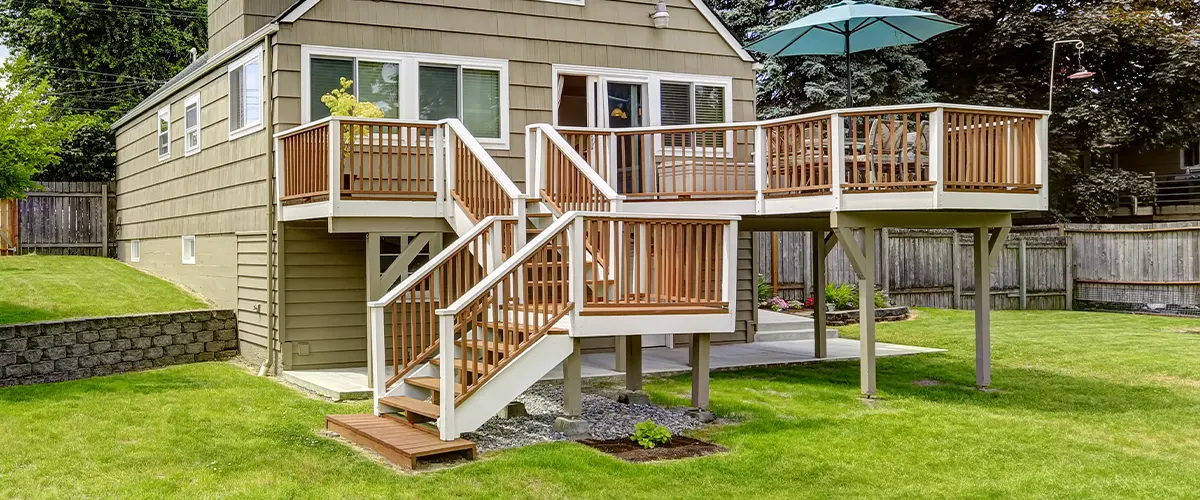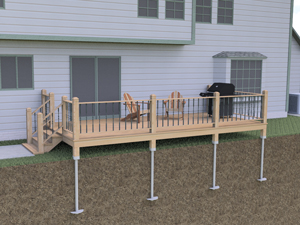Engineered for Success: The Science Behind Durable and Resilient Deck Footings
Engineered for Success: The Science Behind Durable and Resilient Deck Footings
Blog Article
Selecting the Right Deck Footings for Security and Toughness
The long life and security of your deck depend greatly on the kind of footings you pick, as they supply the important assistance and security to endure the examination of time. In this conversation, we will discover the various types of deck footings, take into consideration the essential variables to weigh when making a decision, and dig right into the pros and cons of various options.
Sorts Of Deck Grounds
There are several sorts of deck footings that can be made use of, each offering distinct benefits and factors to consider. One usual kind of footing is the concrete pier ground. These grounds contain a cylindrical opening loaded with concrete, which gives a strong foundation for the deck posts. Concrete pier grounds are reasonably simple to mount and offer exceptional stability, making them a prominent choice for lots of deck tasks.
These grounds are mounted by screwing them right into the ground, which produces a protected foundation for the deck. They additionally enable for simple modification and progressing of the deck if required.
Alternatively, some contractors choose precast concrete footings. These grounds are made from durable concrete and come in different shapes and sizes to suit different deck layouts. Precast concrete grounds are practical to set up and offer a secure base for the deck framework.
Finally, an additional option is the post-in-anchor footing system. This kind of ground involves driving a steel anchor right into the ground and connecting it to the deck message. It offers versatility in terms of placing the deck posts and is ideal for decks with light-weight structures.
When selecting the appropriate kind of deck ground, it is necessary to consider aspects such as soil conditions, deck lots, and local structure codes (Deck Footings). Consulting with an expert contractor or architectural designer can help make sure the suitable ground is chosen for a stable and risk-free deck
Elements to Take Into Consideration When Choosing Footings
When choosing the ideal footings for a deck, it is crucial to very carefully take into consideration various aspects such as dirt conditions, deck lots, and adherence to neighborhood building ordinance. These elements play a considerable duty in guaranteeing the security and sturdiness of the deck framework.
The kind of dirt on which the deck will certainly be constructed establishes the kind of footings needed. On the other hand, decks developed on clay or extensive soils may need grounds that can fit the soil's tendency to increase and contract.
One more crucial element is the deck load. The weight of the deck, consisting of the products used and any potential real-time tons such as furniture or celebrations, need to be taken into account when choosing grounds. The footings must be made to bear the weight of the deck and distribute it equally to stop any architectural problems or failures.
Lastly, adherence to neighborhood building ordinance is critical. Building regulations vary from area to area, and it is necessary to abide by the details demands set by the regional authorities. Deck Footings. These codes make sure that the deck is built securely and meets the essential standards for architectural stability and load-bearing ability
Concrete Footings: Cons and pros

Concrete grounds supply numerous benefits and drawbacks when utilized as the foundation for a deck. On the positive side, concrete footings offer outstanding stability and durability.
Another advantage of concrete footings is their versatility. news They can be poured into different sizes and shapes to accommodate numerous deck styles and setups. Concrete footings can be personalized to fit the particular demands and requirements of the deck framework.
However, there are additionally some disadvantages to using concrete grounds. This can increase the general cost of the deck task and may require professional aid.

Helical Piers Vs. Sonotubes: Which Is Much better?
In thinking about the foundation options for a deck, the comparison in between helical piers and sonotubes is critical in determining the superior choice. They are turned right into the ground utilizing hydraulic machinery, offering a sturdy and secure foundation for the deck.
When it concerns stability and sturdiness, helical piers have the upper hand. The helical plates on the piers develop a strong grip with the dirt, stopping any type of motion or shifting of the deck. This is particularly useful in areas with unstable or moving soil problems. Sonotubes, on the other hand, count only on the concrete loading for stability, which might not provide the very same degree of strength and resistance.
In regards to setup, helical piers are relatively less complicated and faster to install contrasted to sonotubes. The hydraulic equipment used to turn the piers into the ground guarantees a effective and fast process. Sonotubes, on the other hand, need excavating openings and putting concrete, which can be lengthy and labor-intensive.
Additionally, helical piers are a more versatile option. If required, they can be used in various soil problems and can be readjusted or enhanced. Sonotubes, on the other hand, might call for added assistance, such as rebar, in certain soil conditions or areas with high lots needs.
Selecting the Right Footings for Your Deck's Dimensions
For optimal structural stability, it is necessary to meticulously pick the appropriate footings that align with the dimensions of your deck. The dimensions of your deck, including its size, elevation, and size, play a considerable function in figuring out the kind and size of grounds called for.
When choosing grounds for your deck, it is essential to take into consideration the load-bearing ability of the dirt. The weight of the deck, incorporated with the weight of any Source kind of furnishings or individuals on it, puts in a considerable force on the footings (Deck Footings). It is important to select footings that can adequately sustain this weight without sinking or changing over time.
Bigger decks with higher measurements need larger footings to supply sufficient security and support. The form their explanation of the footings, whether they are square or round, depends on the layout and design of the deck.
Conclusion
In verdict, selecting the right deck grounds is important for ensuring stability and resilience. Variables such as the kind of grounds, the deck's measurements, and the pros and cons of various options must be considered. Concrete footings supply strength and durability, but may be more costly and time-consuming to mount. Helical piers and sonotubes have their own benefits and disadvantages. Eventually, picking the appropriate footings for your deck's specific demands is essential for a successful and durable structure.
These footings are composed of a round opening filled with concrete, which provides a solid structure for the deck blog posts. Concrete pier grounds are reasonably very easy to mount and offer exceptional security, making them a preferred selection for several deck tasks.
Precast concrete grounds are hassle-free to mount and provide a stable base for the deck structure.
It offers flexibility in terms of placing the deck blog posts and is ideal for decks with lightweight structures.
Concrete grounds offer a number of advantages and drawbacks when used as the foundation for a deck.
Report this page